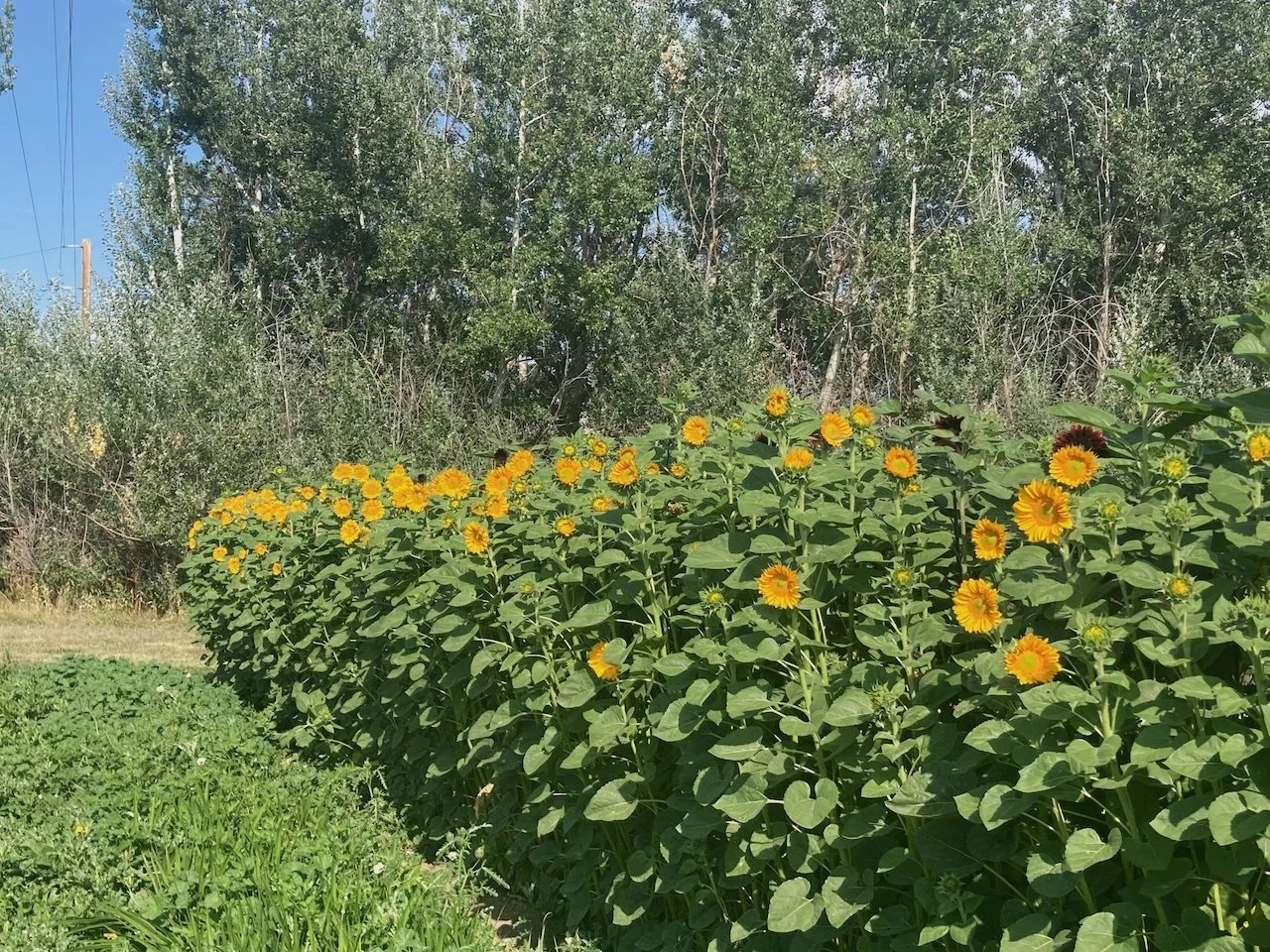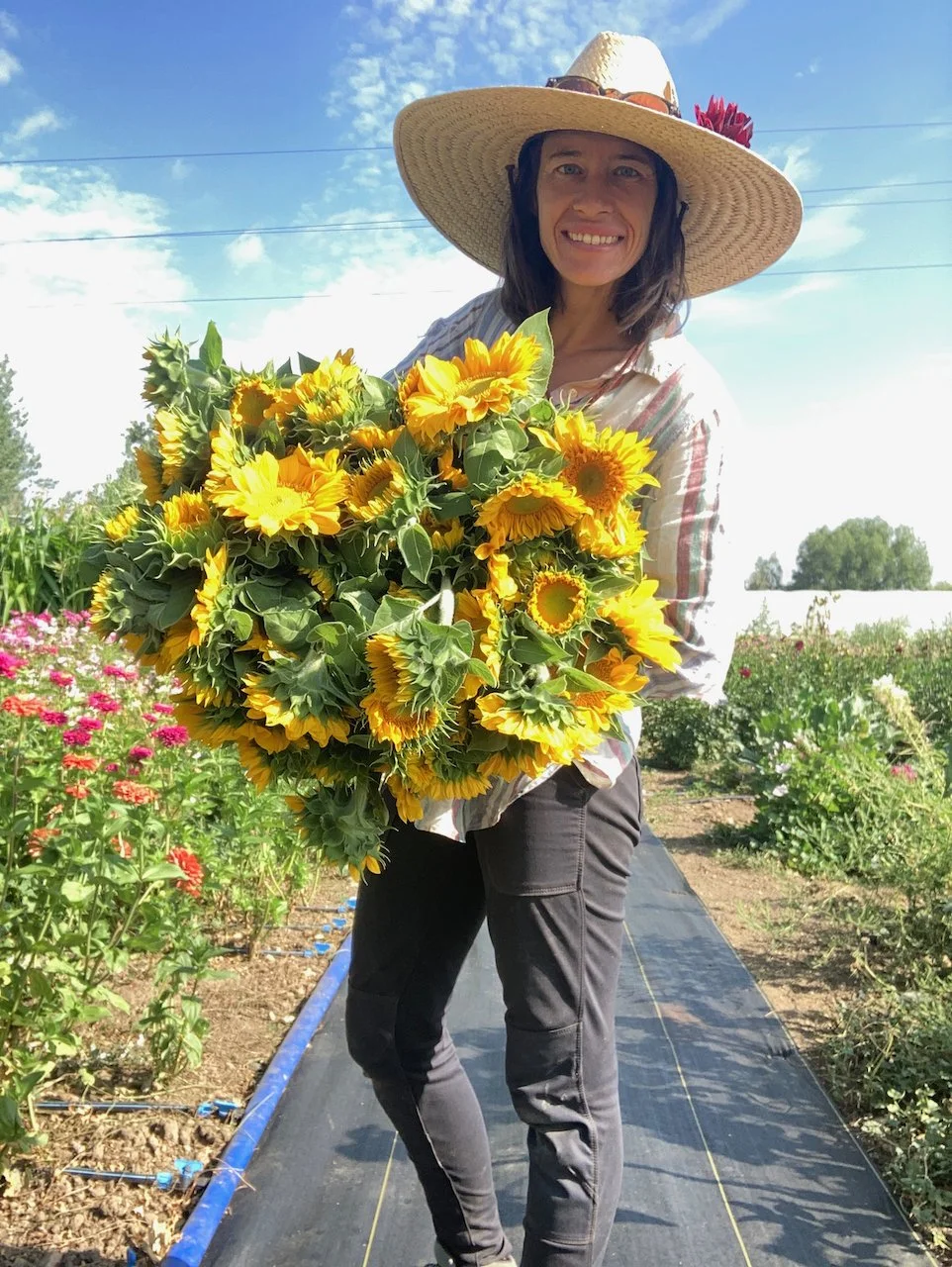Sunflowers: Flower Spotlight
This article comes from our series of flower spotlights, which are adaptations of the newsletters we send to members of our flower share throughout the season. You can see more spotlights by heading here.
Helianthus annuus, Sunflower
A wall of sunflowers in our first year on the farm.
Sunflowers are such a staple of grocery and traditional floristry that it may be easy to write them off as humdrum or unexciting. But there is such a broad array of colors and sizes and shapes, and their sheer productivity is so astonishing, that I cannot help but be in awe of these enormous, complicated, and historically rich sun lovers.
The genus name Helianthus comes from the Greek helios, meaning ‘sun’, and anthos, meaning ‘flower’ and related to the word anther, referring to the pollen-producing structure on the flower. The genus name annuus simply means ‘yearly’ or ‘annual.’ There are, in fact, other species of sunflower that are perennial — you’ve probably seen them growing along the roadside at the same place every year.
In Floriography, Jessica Roux writes that sunflowers signified ‘false riches’ in the Victorian language of flowers, and that this connotation comes from Spanish conquistadores mistaking Incan fields of sunflowers for literal fields of gold. The Inca used sunflowers to symbolize their sun god, Inti, and often wore gold jewelry shaped like sunflowers. During my Peace Corps service in Ecuador, many indigenous people celebrated Inti-Raymi, the festival for the sun god, which celebrates winter solstice and the return of the light (though around the equator the day length really doesn’t change at all). I remember seeing many sunflower motifs on jewelry and textiles.
We plant a 100-foot bed of sunflowers every week, starting in early April and continuing through mid-July, with sometimes a last hail-Mary succession sowing in the earliest days of August. Many of our varieties are 55-days to maturity, We plant every-other week in the early season, because otherwise all the successions bloom at the same time and there are just too many for us to sell. My favorite way of preparing the ground for sunflowers is by placing a silage tarp over the entire area where I’ll be sowing them: we block off that section of the field as our sunflower patch, prepare the beds with a light wheel-hoeing, and then cover them with a tarp. Each week, we peel back the tarp to expose one bed where we’ll plant that week’s succession, meaning that the very last bed will have been covered for a good three months, eliminating a ton of weed seedlings from the soil’s seed bank. Covering also keeps a lot of moisture in the soil and allows more decomposition at the surface.
In the video above, I take a walk through our sunflower successions in mid-July; later successions are shorter, earlier are taller or blooming!
Word to the wise — when planting sunflowers right next to each other in beds, or next to other flowers, consider the orientation of your rows. If your beds are oriented on an east-west line, your sunflowers will shade the beds to their north. This means you should always start your successions on the northmost edge of your sunflower patch. If you start on the south edge, each bed will shade the succeeding one, and you’ll end up with spindly plants that can’t hold up their heavy heads and a lot more powdery mildew than you would otherwise. Reverse this, of course, if you’re planting sunflowers in the southern hemisphere! If your beds are oriented north-south, you don’t need to worry about this phenomenon, as the beds to either side will get equal amounts of sun and shade throughout the day.
We use the shading phenomenon to our advantage when planting sunflowers among other crops. For example, if we plant a sunflower ed to the south of our gomphrena bed, we’ll get much longer stems on the gomphrena as they reach for the sun out of the sunflowers’ shade. Planting sunflowers at the same time as transplanting the short crop will ensure that the transplants have plenty of sun as they are getting established and growing vegetatively, and then their stem lengths will benefit from the shade of the sunflowers (now tall) as they begin to flower.
Mesmerizing Fibonacci sequences 🌀 ProCut Gold sunflower
We plant a broad range of sunflowers, but the most popular for our florist customers are definitely the dark red and light-centered ones, so we plant a lot of ProCut Plum, ProCut Red, and ProCut White Lite, but we also reserve a place for traditional sunflowers with a dark disk and yellow petals. I’m pretty excited about the breeder Sunflower Steve, who’s working on a mix of new sunflower colors and shapes that look absolutely enchanting. Of course, I’m partial to sunflowers that don’t fit into the salable categories (looking at you, Sunrich Lime), or ones that are really nice, but are too expensive to justify - Copper Queen comes to mind. What a gorgeous flower, but the seeds are even more expensive than the ProCut fancy series! Everyday florists want traditional sunflowers, event florists want muted and muddy colors, while market customers want BIG sunflowers or novelties. We try to satisfy each market.
We direct-seed 6 rows on our 4’ wide beds, with 2-3” between seeds, using our Jang seeder, usually the C-12 or G-12 roller. Sunnies need good seed-to-soil contact to germinate, so we press down a little harder than usual on the seeder as we roll along. If we wanted thicker stems and larger heads, we’d plant at more like 4-5” between seeds, but we like the be able to use sunflowers in our market and subscription bouquets, and florists seem to like them at a smaller stem diameter as well.
When a succession is finished, we usually let the stalks stand in the field for a while, and then we’ll mow it down using our flail mower, which works magic on sunflower stalks! You think you’ll never ever be able to mow them down, but the flail makes quick work of even the beefiest stems.
I invite you to look deep into your sunflowers whenever you find them, and you’ll see their beautiful structure of tiny spiraling flowers that progressively open from the outside to the inside. Each flower can be pollinated and become a nutritious seed on the face of the flower. The outer ray flowers are really only there to guide pollinators to the disk flowers. Sunflowers are a prime example of the beautiful spiral geometry inherent in so many flowers and in natural patterns at large. I hope you enjoy staring into the abyss as much as I do!
Happy farmer




